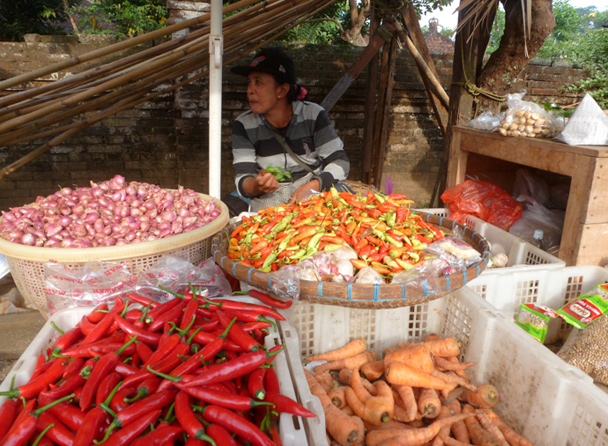Bali can still pass, in spots, for a tranquil island haven. If you loop around the island’s northeastern fringes and back roads, past the Hindu temples, one-street villages, and old-fashioned crafts shops, you will still see a South Pacific Brigadoon. But the island’s southern coast has exploded as a premier beach vacation for New Zealanders and Australians, as tourism rebounded in the last five years after a slight dip due to the 2005 terrorist bombings. Recent overexposure has made for high-season crowds, traffic jams, and bad souvenir stands; the popularity of an “Eat, Pay, Leave” T-shirt—which pays cranky homage to the recent uptick of global visitors inspired by Elizabeth Gilbert’s 2006 memoir and the resulting Julia Roberts movie—may be the best emblem of an increasingly inundated island.
Yet the new commerce in plastic Buddha coin banks that clearly miss the spiritual point has also meant a big payoff for diners. A new wave of ambitious, largely expat chefs, lured themselves by all the hype, are suddenly competing in a serious cook-off aimed at the flow of urbane visitors. On Saturday night, the manic main streets of Bali’s resort hubs, lined with cafés, clubs, bistros, and luxurious restaurants, can look more like Tribeca-meets-SoMa than any Bali Hai idyll.
How to taste the best of Bali’s buffet? The trick is to sample from both the most traditional kitchens and the most inventively updated ones. Start in the southern pocket around the thriving resort town of Seminyak, where the food compensates for the mobs flapping around in flip-flops. Breakfast is the time to sidestep the island’s trendier new kitchens and focus on Bali’s authentic cuisine and local chefs. On the main street of Jimbaran, about 20 minutes outside Seminyak (and about 10 minutes south of the airport if you’re itching to start your Bali smorgasbord), the fishing village’s stalls are piled with peppers; fresh lime; ginger; turmeric; coconut oil; spiky jackfruit; sweet, crisp rose apples; six kinds of mango; yellow and red watermelon; papaya; and the salak fruit, whose nubby skin resembles a basket weave.
Surpassing even that bounty, though, is the line-caught daily haul on exuberant display at the Jimbaran fish market, just outside of town on the waterfront (go between 6 and 9 a.m. for the best catch). Pass the wooden fishing boats, painted bright blue and yellow, beached on the sand above Jimbaran Bay, and you enter a maze of vendors selling red snapper, parrot fish, coral trout, mahi mahi, tiger prawns, and mud crabs. For the supreme seaside breakfast picnic, have your choice of fish thrown on the massive grill framing the market. The alternative: Stop at one of the roadside warungs—a.k.a. food shacks—that line the street outside the market, where the sweet squid, lobster, mussels, and clams are grilled over coconut husks. You’ll be sitting on wobbly plastic chairs and probably sharing a table. But the sound of the waves slapping against the sand, just down the beach, fully compensates. The best of these native diners are Ganesha Cafe, Uluwatu Cafe, and Pandan Sari Cafe.
If that seems too fishy for brunch or you want to add turf to the surf, move on to the neighboring village of Nusa Dua, where the suckling pig at the Warung Sari Dewi, at Srikandi 9, is a work of high culinary art. First peek into the cooking hut behind the warung and watch two crouching women slowly turn whole six-month-old pigs, mounted on a spit just to the side of a wood fire, until the pork skin is lacquered golden and beaded with juice. Then join the line of locals at the counter in the four-table dining room and order what everyone else is having (in fact, it’s the only thing available): a $2.25 paper cone filled with chunks of the just-roasted pig, sticky rice, spicy chiles, and crispy strips of pork skin.
If that cone seems to qualify more as appetizer than main meal, consider a study in contrasts: While the homely warung is one traditional foundation of Bali’s food scene, a more recent source of culinary inspiration is the anything-but-shacklike sleek beach resort. These resorts, many of which sprang up in the 1980s, have become known as much for their slightly tweaked regional cuisine as their posh beachside villas. Among the best of those, near Seminyak, is Amanusa (one of several properties run by Aman, a company that established the template for stylish, authentic yet streamlined South Pacific resorts). Amanusa’s open-air (and open to the public) Terrace dining room sits perched above the ocean so lunch comes salted by a briny sea breeze. The thing to order from the casual all-day menu is a shrewdly edited version of Balinese rijsttafel that reduces the classic, multidish buffet to a single heaped plate of supernal nasi goreng (fried rice crowned with chicken and a fried egg). Just as good is the kitchen’s wok-fried soft-shell crab, all delicate crunch, paired with a spicy pomelo salad, and the mango parfait dressed up with white chocolate, almond praline, and mango coulis. Stay for dinner and you can sample from a broader selection of Indonesian classics: grilled prawns with roasted coconut and turmeric dressing; Javanese lamb curry roused by lemongrass, cardamom, and coconut milk; minced seafood satay; spicy grilled chicken curry with tomato and cabbage; slow-roasted duck in palm bark with cassava leaf; and grilled beef curry with garlic, turmeric, and lime leaf. If you want to make dessert yourself, executive chef Hamish Lindsay offers cooking classes that let you master a pitch-perfect yogurt and vanilla bean mini-soufflé, or just about any other dish you’d like to learn to make.



 Pinterest
Pinterest


